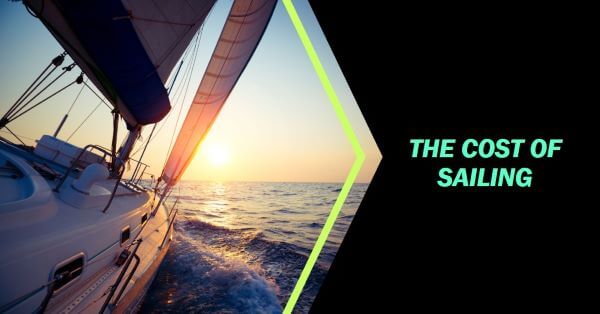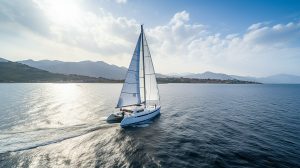Sailing is costly due to high initial investment (boat, safety gear), maintenance costs, docking fees, and fuel. Additionally, sailing lessons, insurance, and potential repair costs add to the expenses. Not to mention the value of time spent in learning and practice.
Table of Contents
- Is it expensive to go Sailing?
- Why have boats become so expensive?
- The Cost of Owning a Sailboat
- Factors Affecting the Price of Sailing Equipment
- Expenses Associated with Sailing Trips
- Additional Costs in Competitive Sailing
- Strategies to Reduce Sailing Expenses
- Conclusion for, Why is Sailing Expensive?
- Frequently Asked Questions
- Read other Sailing Lifestyle Posts here:
Is it expensive to go Sailing?
Yes, going sailing can be expensive. Costs include chartering or owning a boat, maintenance, insurance, fuel, docking fees, and sometimes hiring a crew or taking lessons. However, cost varies depending on the boat's size, location, and how often you sail.

Why have boats become so expensive?
- Raw Material Costs: The prices of essential materials like fiberglass, steel, and wood have risen, directly influencing boat prices.
- Labor Costs: Skilled labor for boat construction and maintenance is becoming more expensive due to increasing wage standards.
- Technological Advancements: Modern boats often feature advanced navigation, safety, and comfort technologies, which add to the cost.
- Regulation and Safety Standards: Meeting these standards often involves additional costs, which are passed on to the consumer.
- Demand and Supply: In recent years, demand for boats has grown, outpacing supply, leading to higher prices.
- Inflation: Like any other industry, the boating industry is also affected by general economic inflation.
The Cost of Owning a Sailboat
Owning a sailboat is a big investment. Let's look at why it can be expensive.
| Expense | Cost Range |
| Boat Purchase | $10,000 - $1 million |
| Maintenance and Repairs | 10-15% of boat's value annually |
| Mooring or Docking Fees | $2,000 - $24,000 per year |
| Insurance | 1-2% of boat's value each year |
Buying a sailboat can cost anywhere from $10,000 for old models to $1 million for luxury yachts. Plus, you need to spend 10-15% of the boat's value yearly on maintenance and repairs. Mooring and docking fees range from $2,000 to $24,000 annually, and insurance is 1-2% of the boat's value each year.
Sailing has a long history, including centuries of use as a means of transportation for exploration and trade. Nowadays, it's a recreational activity with modern boats and equipment, but the expense remains a big part of it.
Factors Affecting the Price of Sailing Equipment
Sailing equipment costs are impacted by heaps of factors. It's important to know these, both for newbies and experts! To help, check out the table below:
| Factor | Description |
|---|---|
| Quality | Top-notch gear tends to cost more due to superior materials and workmanship. |
| Technology | Equipment with advanced tech often has a higher price tag. |
| Brand | Well-known, reliable brands usually cost more. |
| Functionality | Special features and designs drive up the cost. |
| Durability | Sturdy gear may cost more initially, but it's worth it in the long run. |
| Complexity | Complex equipment needing specialized skills costs more. |
Furthermore, production, supply chain dynamics, and market demand affect pricing decisions.
Pro Tip: Consider renting or buying second-hand gear in good condition, to save money while still guaranteeing quality and functionality.
Expenses Associated with Sailing Trips
Sailing trips can be pricey due to many expenses. Let's look at some of these costs.
Expenses Related to Sailing:
- Boat Rental: This affects the overall cost of a sailing trip. Rental price depends on size, type and duration.
- Fuel: Sailboats often require engines, like diesel or gasoline, particularly when there is no wind.
- Maintenance: Needed to keep the boat safe and functional. Repairs, upgrades and services cost money.
- Docking Fees: May be incurred at ports and marinas. Fees vary depending on location, time of stay, and amenities.
- Provisions: Buy food and supplies for the trip. Consider storage limits to avoid waste or shortages.
- Insurance: Boat insurance helps protect in case of accidents. Cost depends on coverage.
- Navigation Tools: Nautical charts, GPS, compasses and other aids are needed for safe sailing, but they cost extra.
- Sailing Gear. Top quality sailing gear can be expensive. See Quantum Sailing Gear.
These are expenses related to sailing trips. Also, participating in races or competitions may require registration fees, plus specialized equipment.
Jack's story: He went sailing for a month last summer in the Caribbean. He was excited, but soon realized how expensive it was. Boat rental, provisions, docking fees and repairs added up. Despite this, Jack enjoyed his journey and the lessons he learned.
Additional Costs in Competitive Sailing
Competitive sailing has extra costs. A boat can cost thousands to tens of thousands of dollars. Necessary gear is needed, like sails, rigging, and helmets. Professional coaching or camps require fees and travel. Races and regattas may need accommodation, transportation, and entry fees. Boat maintenance for cleaning, repairs, and parts is necessary. Race fees vary. Insurance is required. Crew members need food and accommodation. Costs depend on the level of competition and what gear/training are chosen. Networking can lead to sponsorships and shared expenses to reduce costs.
Strategies to Reduce Sailing Expenses
Sailing can be pricey, yet there are ways to lessen the financial burden. Here are some smart strategies to cut costs:
- Don't buy a boat, rent one! This can save you lots on maintenance and storage.
- Join a sailing club or association. These offer memberships with discounted rates.
- Pick off-peak seasons. Marinas and charter companies often give discounts during these times.
- Go with friends or like-minded people. Splitting fees and costs can make sailing more budget-friendly.
Plus, investing in sailing skills has its own rewards. Courses and certifications can make you more competent, and may even qualify you for discounts.
Conclusion for, Why is Sailing Expensive?
Sailing is a thrilling experience, but it comes with a hefty cost. Quality gear, maintenance, and professional training all add to the expense. But the priceless experiences make it worth it!
You'll need to invest in essential sailing equipment—sails, ropes, navigation instruments, safety gear. Plus, regular maintenance for the wear and tear of water and weather.
Professional training is a must. You'll learn boat handling, read weather patterns, and understand maritime laws. Proper training ensures your safety and a great experience at sea.
Sailing can also be expensive for regattas or races. Entry fees, travel costs, and accommodations are all additional costs. But you can test your skills against other sailors and enjoy friendly competition.
The captivating beauty of sailing draws people in. You can master nature's forces and live a life of freedom and adventure. Don't let finances stop you—embrace sailing and its unforgettable experiences!
Dive into the incredible world of sailing. Feel the wind on your face and the thrill of the open waters. Create lasting memories and forge connections with other sailors. Take the plunge and make your dreams come true. Set sail!
Frequently Asked Questions
Q: Why is sailing expensive?
A: Sailing can be expensive due to various factors such as the cost of purchasing or renting a sailboat, maintenance and storage fees, fuel expenses, insurance, equipment and gear, training and certification courses, marina fees, and the overall upkeep required for a sailing lifestyle.
Q: Are there any additional costs associated with sailing?
A: Yes, apart from the basic expenses, there can be additional costs such as regatta entry fees, club memberships, navigation charts, safety equipment, repairs and upgrades, mooring fees, and the cost of accommodation and provisions during longer sailing trips.
Q: Can I sail without owning a boat?
A: Yes, it is possible to sail without owning a boat. Many places offer boat rentals or charters, allowing individuals to enjoy sailing without the upfront costs of owning a vessel. However, rental prices can still be high depending on the duration and type of boat desired.
Q: Are there ways to reduce sailing expenses?
A: Yes, there are several ways to reduce sailing expenses. Sharing boat ownership or joining sailing clubs can help in splitting costs. Learning basic boat maintenance skills can also save money on repairs. Additionally, planning shorter trips or exploring local waters instead of long-distance voyages can cut down on fuel and mooring costs.
Q: Do I need any special training to sail?
A: While no formal training is legally required in many places, it is highly recommended to undergo sailing courses and gain practical experience before venturing out on your own. Training ensures safety, teaches navigation skills, and helps in handling emergencies, ultimately reducing the risk of accidents and damage to the boat.
Q: Is sailing an expensive hobby compared to other water sports?
A: Sailing can be more expensive compared to some other water sports due to the initial investment required to purchase a sailboat and the additional costs associated with maintenance, storage, and various fees. However, the expenses can vary depending on the specific sport, location, and individual preferences.
Read other Sailing Lifestyle Posts here:
- What is Blue Water Sailing? All you need to know.Blue water sailing is an exciting and challenging form of sailing that involves voyages across open waters, typically beyond the sight of land. It is a thrilling way to explore the vastness of the ocean, test your skills, and push your limits. Whether you are a seasoned sailor or someone who has never sailed before,… Read more: What is Blue Water Sailing? All you need to know.
- Is Blue Water Sailing Dangerous? Uncover the Truth Today!Embarking on a blue water sailing journey can be a thrilling experience, but it also comes with inherent risks. Long-distance sailing can be challenging and unpredictable, making it crucial to understand the potential hazards and prepare accordingly. In this section, we will explore the question of whether blue water sailing is dangerous. We will discuss… Read more: Is Blue Water Sailing Dangerous? Uncover the Truth Today!
- Exploring What Size Catamaran for Blue Water Sailing Is IdealPlanning a blue water sailing adventure requires careful consideration of various factors, including the size of the catamaran. The size of the catamaran plays a critical role in ensuring a comfortable and safe journey on the open ocean. But what size catamaran for blue water sailing is ideal? In this section, we will explore the… Read more: Exploring What Size Catamaran for Blue Water Sailing Is Ideal
- Easy & Non Messy Boat Snacks for Your Next Sailing Adventure!Welcome aboard, fellow sailors! As you prepare for your next adventure on the water, one thing you don't want to forget is snacks. However, the last thing you want is to deal with messy, crumbly snacks that leave a trail behind and attract unwanted bugs. That's why it's important to opt for non messy boat… Read more: Easy & Non Messy Boat Snacks for Your Next Sailing Adventure!
- Easy & Delicious Finger Food Ideas for Boating AdventuresWelcome aboard! No boating adventure is complete without some delicious and easy-to-eat finger foods. Whether you're cruising down the river or sailing into the sunset, having the right snacks is essential for a successful day on the water. If you're looking for some inspiration for your next boating trip, look no further. We've rounded up… Read more: Easy & Delicious Finger Food Ideas for Boating Adventures






